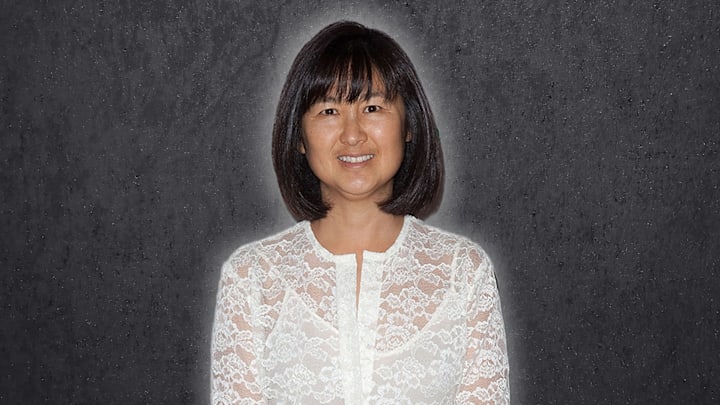Sculptor and architect Maya Lin is best known for her design of the Vietnam Veterans Memorial in Washington, D.C., but modern viewers may not know about her rise to prominence and the subsequent controversy. Let’s take a look at five interesting facts about the architect from Athens, Ohio.
- Maya Lin had an early start.
- She had her share of critics.
- Maya Lin had one very polite ally.
- Her critics ended up eating crow.
- The Vietnam Veterans Memorial wasn’t Maya Lin’s only controversial win.
Maya Lin had an early start.
Lin’s design has become so celebrated that it’s easy to forget how young she was when she first proposed it. The national contest to design a Vietnam memorial drew 1421 entries, including such oddball suggestions as a steel soldier’s helmet the size of a house, but in the end, Lin’s granite wall won the competition. She wasn’t a seasoned architect and sculptor, though; when Lin won she was still a 21-year-old senior at Yale.
Although the victory obviously kickstarted Lin’s career, it also led to some awkward situations. Lin had originally designed the monument as a project for a class on funerary architecture with Professor Andrus Burr. Burr had submitted his own design in the memorial competition but lost out to Lin.
She had her share of critics.

Lin had to weather harsh criticism from a variety of sources. The National Review denounced Lin’s project as “Orwellian glop.” Vietnam veterans decried it as a “black gash of shame.” And those were the nicer critiques. Tom Wolfe and Peter Schlafly witheringly dubbed it “a tribute to Jane Fonda.” While Lin had intended for the wall’s simplicity to prompt introspection and honor for the fallen soldiers, many critics just thought it was bleak or strange, particularly because the soldiers’ names were listed chronologically rather than alphabetically.
Ross Perot might have been Lin’s most visible opponent, though. The tycoon and future presidential candidate had put up $160,000 to help fund the design competition, but he dismissed the winning design as “something for New York intellectuals.” Lin later told The New Yorker that Perot even visited her office and asked, “Doncha just think they need a parade?” Lin responded, “Well, they really need more than a parade.”
Maya Lin had one very polite ally.
As veterans’ groups and Perot were publicly agitating for Lin’s design to either be scrapped or heavily modified, Lin found an unlikely advocate: Miss Manners. Judith Martin, better known to the world as the etiquette columnist, took Lin under her wing during the architect’s tumultuous time in Washington as she tried to get the memorial built. Martin, along with Washington Post architecture critic Wolf von Eckardt, helped Lin get some positive publicity to sway attitudes in favor of her project.
Her critics ended up eating crow.
Although Lin’s design was controversial when it was in the planning stages, once it was built a number of her more outspoken critics changed their stances. Lin later told PBS that the critic who had penned the “Orwellian glop” insult wrote her a very nice letter to apologize. Lin recounted that the critic wrote, “I’m really sorry. I made a mistake.”
In the end, Lin took all of the controversy in stride. In the same PBS interview she said the only people she ended up really thinking less of because of the whole fracas were Ross Perot and Secretary of the Interior James G. Watt, who held up the memorial’s building permits in an attempt to change the design.
The Vietnam Veterans Memorial wasn’t Maya Lin’s only controversial win.
For a while, Lin seemingly couldn’t escape controversy no matter how hard she tried. In 1994, documentary filmmaker Freida Lee Mock won the Academy Award for Best Documentary Feature for her film Maya Lin: A Strong Clear Vision. Nice honor for Lin as the film’s subject, right? Not so much. Turns out that Lin was part of another award-winning project that drew considerable fire.
While most critics agreed that the film about Lin was a perfectly good documentary, they couldn’t understand why Hoop Dreams, which most viewers thought was a vastly superior film, couldn’t even garner a lousy nomination for the Oscar. After similarly praised docs like The Thin Blue Line and Roger & Me had suffered the same slight, many insiders began agitating for a new way to nominate documentaries. Since Mock had formerly chaired the Academy’s documentary committee, conspiracy theorists leveled charges of cronyism against the award.
The real problem, though, was that the criteria for garnering a nomination were a bit bizarre. Since the Academy only had 47 people on its documentary nomination committee—as opposed to 400-plus on its foreign film committee—it was incredibly difficult to screen every potential nominee. While most categories required that films be shown for at least a week in a theatrical run in Los Angeles, best doc nominees could only be drawn from a list of films that had appeared at a select handful of festivals. This system did help cut the undermanned committee’s workload, but it also led to head-scratching omissions from the final lists of nominees.
The Lin documentary’s controversial win (and Hoop Dreams’ snub) ended up being the last straw for documentary filmmakers. Within a year the Academy added a second documentary review committee in New York and began requiring a weeklong theatrical run for eligibility in the category.
Read More About Monuments and Memorials:
A version of this story originally ran in 2010; it has been updated for 2025.
